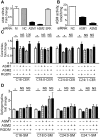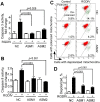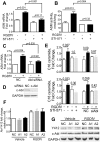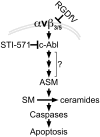c-Abl is an upstream regulator of acid sphingomyelinase in apoptosis induced by inhibition of integrins αvβ3 and αvβ5
- PMID: 22879933
- PMCID: PMC3411766
- DOI: 10.1371/journal.pone.0042291
c-Abl is an upstream regulator of acid sphingomyelinase in apoptosis induced by inhibition of integrins αvβ3 and αvβ5
Abstract
Inhibition of integrins αvβ3/αvβ5 by the cyclic function-blocking peptide, RGDfV (Arg-Gly-Asp-Phe-Val) can induce apoptosis in both normal cells and tumor cells. We show that RGDfV induced apoptosis in ECV-304 carcinoma cells, increased activity and mRNA expression of acid sphingomyelinase (ASM), and increased ceramides C(16), C(18:0), C(24:0) and C(24:1) while decreasing the corresponding sphingomyelins. siRNA to ASM decreased RGDfV-induced apoptosis as measured by TUNEL, PARP cleavage, mitochondrial depolarization, and caspase-3 and caspase-8 activities, as well as by annexinV in a 3D collagen model. These findings indicate a causal role for ASM in RGDfV-induced apoptosis in ECV-304. We have shown that c-Abl, a non-receptor tyrosine kinase, also mediates RGDfV-induced apoptosis. However, c-Abl, has not been previously linked to ASM in any system. Here we show that STI-571 (imatinib, inhibitor of c-Abl) inhibited RGDfV-induced ASM activity. Furthermore, STI-571 and c-Abl-siRNA both inhibited RGDfV-induced increase in ASM mRNA, but ASM-siRNA did not affect c-Abl phosphorylation or expression, supporting that c-Abl regulates the RGDfV-induced increase in ASM expression. These studies implicate ASM as a mediator of apoptosis induced by inhibition of integrins αvβ3/αvβ5, and for the first time place c-Abl as an upstream regulator of ASM expression and activity.
Conflict of interest statement
Figures






Similar articles
-
Endothelial apoptosis induced by inhibition of integrins alphavbeta3 and alphavbeta5 involves ceramide metabolic pathways.Blood. 2005 Jun 1;105(11):4353-61. doi: 10.1182/blood-2004-08-3098. Epub 2005 Feb 10. Blood. 2005. PMID: 15705795 Free PMC article.
-
c-Abl mediates endothelial apoptosis induced by inhibition of integrins alphavbeta3 and alphavbeta5 and by disruption of actin.Blood. 2010 Apr 1;115(13):2709-18. doi: 10.1182/blood-2009-05-223776. Epub 2010 Feb 2. Blood. 2010. PMID: 20124512 Free PMC article.
-
A selective cyclic integrin antagonist blocks the integrin receptors alphavbeta3 and alphavbeta5 and inhibits retinal pigment epithelium cell attachment, migration and invasion.BMC Ophthalmol. 2005 Jun 29;5:16. doi: 10.1186/1471-2415-5-16. BMC Ophthalmol. 2005. PMID: 15987521 Free PMC article.
-
Potential role of acid sphingomyelinase in environmental health.Zhong Nan Da Xue Xue Bao Yi Xue Ban. 2012 Feb;37(2):109-25. doi: 10.3969/j.issn.1672-7347.2012.02.001. Zhong Nan Da Xue Xue Bao Yi Xue Ban. 2012. PMID: 22561428 Review.
-
Secretory sphingomyelinase in health and disease.Biol Chem. 2015 Jun;396(6-7):707-36. doi: 10.1515/hsz-2015-0109. Biol Chem. 2015. PMID: 25803076 Review.
Cited by
-
CSF1R signaling blockade stanches tumor-infiltrating myeloid cells and improves the efficacy of radiotherapy in prostate cancer.Cancer Res. 2013 May 1;73(9):2782-94. doi: 10.1158/0008-5472.CAN-12-3981. Epub 2013 Feb 15. Cancer Res. 2013. PMID: 23418320 Free PMC article.
-
EDIL3/Del-1 prevents aortic dissection through enhancing internalization and degradation of apoptotic vascular smooth muscle cells.Autophagy. 2024 Nov;20(11):2405-2425. doi: 10.1080/15548627.2024.2367191. Epub 2024 Jul 1. Autophagy. 2024. PMID: 38873925 Free PMC article.
-
PID1 (NYGGF4), a new growth-inhibitory gene in embryonal brain tumors and gliomas.Clin Cancer Res. 2014 Feb 15;20(4):827-36. doi: 10.1158/1078-0432.CCR-13-2053. Epub 2013 Dec 3. Clin Cancer Res. 2014. PMID: 24300787 Free PMC article.
References
Publication types
MeSH terms
Substances
Grants and funding
LinkOut - more resources
Full Text Sources
Research Materials
Miscellaneous

